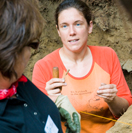 “Some thought I was a descendant of pirates and that I had a map and knew just where the gold was,” archaeologist Heidi Savery says with a smile. She was digging in Bluefields, Jamaica, one of that country’s last developed coastlines, in 2008. A housing project had unearthed a significant pre-Columbian Taíno site and community leaders had invited her to document the site.
“Some thought I was a descendant of pirates and that I had a map and knew just where the gold was,” archaeologist Heidi Savery says with a smile. She was digging in Bluefields, Jamaica, one of that country’s last developed coastlines, in 2008. A housing project had unearthed a significant pre-Columbian Taíno site and community leaders had invited her to document the site.
But the residents were suspicious.
“People would sometimes sit out there with their arms crossed just watching our every move, watching the screens to see what people were picking up and laughing that we were picking up rocks and pottery,” says Savery, a doctoral student at Binghamton.
She laughs at the memory but is quick to point out that this reaction is understandable given that outsiders have been stealing from the country for centuries, from the days of Christopher Columbus to the present, when most of the tourist industry, by far Jamaica’s largest, is largely owned by foreign entities that take most of the profits out of the country.
“That’s where that suspicion comes from,” Savery says. “And you have to take that very seriously.”
To help people understand her motives, Savery invites school children and opens the site to anyone who wants to learn basic archaeology techniques. She hopes that what community members unearth will spark a larger conversation about heritage and help them demand responsible social and economic development through eco-friendly, community-based tourism.
“Archaeologically speaking, Bluefields is like an open frontier because so little work has been done there,” Savery says. “And as development is sort of looming in the background, it’s important to document all we can, but also to assist the community in the negotiations as to what kind of development, what will be developed and how it will develop.”
Partnering with Missouri State University, the University of the West Indies, Northern Caribbean University, several community groups and a host of researchers and developers, Savery deepened her involvement with the community and started surveying estate houses of landowners interested in attracting tourism. One possible outcome is a heritage trail that links historic landscapes with contemporary communities.
“The community is very much involved in not only the process of archaeology, but the development and the design,” she says. “They are a driving force and inspiration in the Bluefields Archaeology Project.”
Savery’s work has earned her a Fulbright scholarship, which will allow her to intern with the Bluefields People’s Community Association and Jamaica National Heritage Trust so she can understand the complex relationship between archaeology and tourism in Jamaica.
“If we can help the community develop natural and cultural resources in such a way that has really wide-spread benefit, they don’t have to sell out to these larger, all-inclusive hotels,” Savery says. “We’re trying to make tourism work for heritage, rather than the other way around.”








We will be doing a birdwatching tour in March in Jamaica. We recently learned about your work at an archaeology conference in Massachusetts. We would like more information about your work and some suggestions as to how to go about learning more about archaeology in Jamaica. We hope to spend a few extra days there. Thanks.
Glad to hear you’ve chosen to visit our beautiful island. The Bluefields area is among the best for birdwatching with many endemic species. It is also one of the least known and well preserved parts of the island. I would be happy to give you some more information on Jamaica’s heritage & archaeology. Feel free to contact me at hsavery1@binghamton.edu.